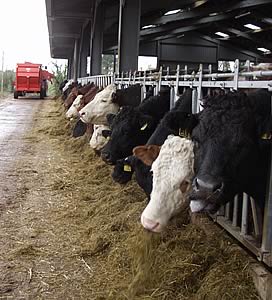25/11/08
Dairy, beef and sheep farmers face an increased risk of severe acidosis amongst their livestock this winter as the temptation to feed large quantities of cheap cereals takes hold.
Wheat prices have tumbled over recent months, with prices currently around £85-90 per tonne ex-farm. As a result, there is genuine concern that many livestock farmers will be tempted to over-feed wheat and barley during the winter.
“Wheat is an excellent feed stuff, and at current prices represents great value for money,” claims Steve Brown, ruminant technical manager for Wynnstay Feeds. “But farmers should be aware of the risk of acidosis if it is fed in high quantities to animals whose rumens need the correct balance of starches and sugars in relation to digestible fibre in order to be able to work properly.”
“The rumen works best at a pH of around 6.0,” Mr Brown explains. “Feeding too much wheat could cause the pH to drop to a dangerous level, causing acidosis, especially if fed in conjunction with wet and acidic grass or maize silage.”
“The main signs of acidosis are restricted cud chewing, variable daily feed intakes, inconsistent dung containing undigested grain and forage, restless cows, sore feet and generally poor performance. Milk yields can drop by as much as 2 litres per day and bufferfats could be reduced by up to 0.5%. In the worst cases, farmers who fail to recognise the symptoms could see even greater losses,” Mr Brown adds.
Intensively fed lambs and sheep are also at risk, particularly if they are going into the winter under conditioned as a result of the summer’s wet grazing conditions. The temptation is to feed high levels of cereals to put condition back on, but this must be done as part of a balanced diet.
Mr Brown advises farmers to ensure that they maintain healthy rumen function by balancing winter diets with a source of digestible fibre and other rumen buffers. “Sugar beet pulp would provide the ideal source of fibre,” Mr Brown suggests, “but it is currently £50 per tonne too expensive. Instead, farmers can use concentrates containing good levels of toasted soya bean hulls or citrus pulp as a more cost effective way of buffering the rumen.”
Mr Brown also recommends the inclusion of live yeast and sodium bicarbonate as additional supplements to improve rumen function. “Feeding just 50 grammes of live yeast to dairy cows can restore milk yields, whilst 30 grammes per day is enough to boost liveweight gains in beef cattle by up to 10%,” he claims.
A daily supplement of 150-200 grammes of sodium bicarbonate per animal will also improve productivity by neutralising excessive acidity. Cows will become more contented as pH levels improve and the rumen will return to normal function allowing performance levels to recover within a matter of three to four days.
Calvin Pugh of Court Farm in Gloucestershire has been using live yeast and sodium bicarbonate as part of his 230 cow dairy herd’s ration with notable results. “Our cows were looking uncomfortable and starting to suffer from what is best described as indigestion,” Mr Pugh explains. “We had been feeding some acidic maize silage that had been made too early last year. We added Biosprint live yeast as a pre-mix to the cows’ rations along with 200 grammes of bicarbonate. The cows look more contented now that the excessive acid has been neutralised and they are performing better all round.”
Mr Brown of Wynnstay estimates that using a combination of live yeast and sodium bicarbonate will cost dairy farmers as little as 10 pence per animal per day. “At an average milk price of 25 pence per litre, an increase of 2 litres per day will see a 5:1 return against costs for the worst affected animals.”
 RABDF Calls for Immediate Action to Stem Further TB Spread RABDF Calls for Immediate Action to Stem Further TB Spread
 Mastitis Warning from Damp Straw Mastitis Warning from Damp Straw
 Fort Dodge Launches Cattle Bluetongue Vaccine in Scotland Fort Dodge Launches Cattle Bluetongue Vaccine in Scotland
|



